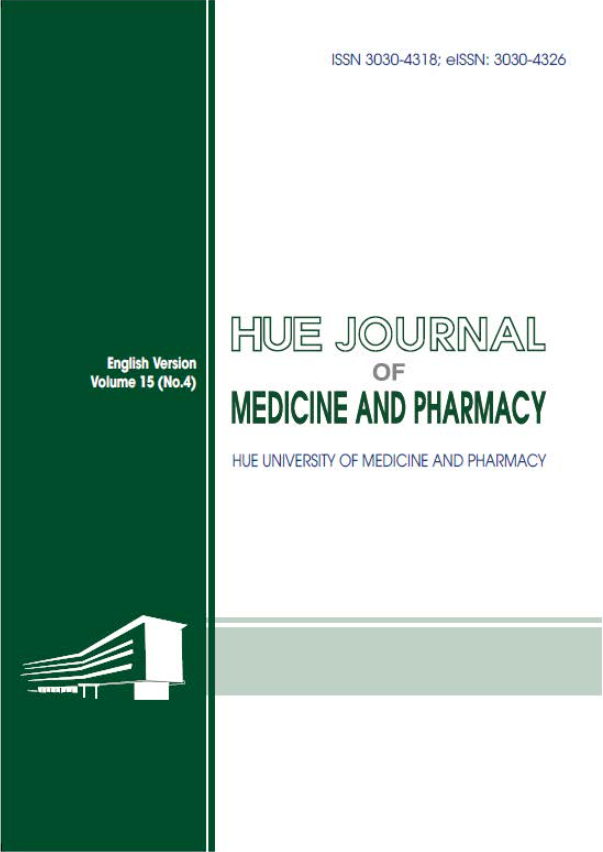Tóm tắt
Background: Pain following a cesarean section can hinder a mother’s recovery after childbirth, disrupt the mother-child bond, negatively impact the mother’s mental well-being, and hamper breastfeeding. The accurate assessment of pain levels and the proper use of pain relief methods can significantly improve the physical and mental health of mothers and babies. This support can aid in quick recovery after a cesarean section, create optimal conditions for mother-child bonding, and help develop future childcare skills.
Objectives: 1) To describe pain experiences and effectiveness of pain management after cesarean section in postpartum mothers at the Obstetrics and Gynecology Department, Hue University of Medicine and Pharmacy Hospital; 2) To identify factors related to pain experiences after cesarean section in postpartum mothers.
Subject and methods: Cross-sectional study design among 190 postpartum mothers after cesarean section on the 2nd day at the Obstetrics and Gynecology Department, Hue University of Medicine and Pharmacy Hospital from August 2021 to July 2022. Results: The average pain level of the study group was 5.98 ± 0.923/10. The percentage of postpartum mothers with moderate to severe pain at the time of the most pain was 95.2%. The pain relief method used was first-class analgesics, and the average pain relief level was 5. 47 ± 1.435/10. The study found a statistically significant association between pain experiences after cesarean section and the following factors: age, pregnancy status, number of births, prenatal complications, prenatal anxiety, number of cesarean sections, family support, and types of anesthesia (p < 0.05).
Conclusion: The rate of postpartum mothers experiencing moderate to severe pain after a cesarean section is quite high. However, the effectiveness of postoperative pain management in postpartum mothers is still very low. More effective pain management methods should be applied, especially for individuals with risk factors that increase their pain experiences, to improve the effectiveness of postpartum care and treatment.
| Đã xuất bản | 30-08-2025 | |
| Toàn văn |
|
|
| Ngôn ngữ |
|
|
| Số tạp chí | Tập 15 Số 4 (2025) | |
| Phân mục | Nghiên cứu | |
| DOI | 10.34071/jmp.2025.4.10 | |
| Từ khóa | Caesarean section, effectiveness of pain management, pain severity, pain interference, pain experiences |

công trình này được cấp phép theo Creative Commons Attribution-phi thương mại-NoDerivatives 4.0 License International .
Bản quyền (c) 2025 Tạp chí Y Dược Huế
Betran, Ana Pilar, et al. Trends and projections of caesarean section rates: global and regional estimates. BMJ Glob Health, 2021. 6(6).
Phùng Ngọc Hân, Lê Minh Tâm, Trương Quang Vinh. Chỉ định mổ lấy thai con so tại Bệnh viện Đại học Y Dược Huế. Tạp chí Phụ sản. 2017. 15(1): p. 41 - 46.
Karlström, Annika, et al. Postoperative pain after cesarean birth affects breastfeeding and infant care. J Obstet Gynecol Neonatal Nurs. 2007;36(5):p. 430-40.
Borges, Natalia Carvalho, et al. Dor pós-operatória em mulheres submetidas à cesariana. Enfermería Global, 2016. 16(4).
Demelash, Getamesay, et al. Prevalence and Factors Associated with Postoperative Pain After Cesarean Section at a Comprehensive Specialized Hospital in Northwest Ethiopia: Prospective Observational Study. Open Access Surgery. 2022. Volume 15: p. 1-8.
Gamez, Brock H., and Ashraf S. Habib. Predicting severity of acute pain after cesarean delivery: a narrative review. Anesthesia & Analgesia. 2018. 126(5): p. 1606-1614.
Veef, Ellen, and Marc Van de Velde. Post-cesarean section analgesia. Best Practice & Research Clinical Anaesthesiology. 2022. 36(1): p. 83-88.
Thoại, Nguyễn Huyền, Huỳnh Thanh Ngân, Ngô Duy Thái. hiệu quả của phối hợp Bupivacain với Sufentanil và morphin liều thấp trong gây tê tuỷ sống mổ lấy thai ở Bệnh viện Phụ sản Cần Thơ. Tạp chí Y học Việt Nam. 2025; 550(3).
Nguyen, Tham Thi, et al. Preferences for childbirth delivery and pain relief methods among pregnant women in Vietnam. Frontiers in Medicine. 2024. 11: p. 1290232.
Cleeland, Charles S., and K. M. Ryan. The Brief Pain Inventory. 1991.
Borges, Natalia de Carvalho, et al. Predictors for Moderate to Severe Acute Postoperative Pain after Cesarean Section. Pain Res Manag 2016. 2016: p. 5783817.
Lautenbacher, Stefan, et al. Age changes in pain perception: A systematic-review and meta-analysis of age effects on pain and tolerance thresholds. Neuroscience & Biobehavioral Reviews. 2017;75: p. 104-113.
Duan, Guangyou, et al. Comparison of postoperative pain between patients who underwent primary and repeated cesarean section: a prospective cohort study. BMC Anesthesiol. 2019;19(1): p. 189.






